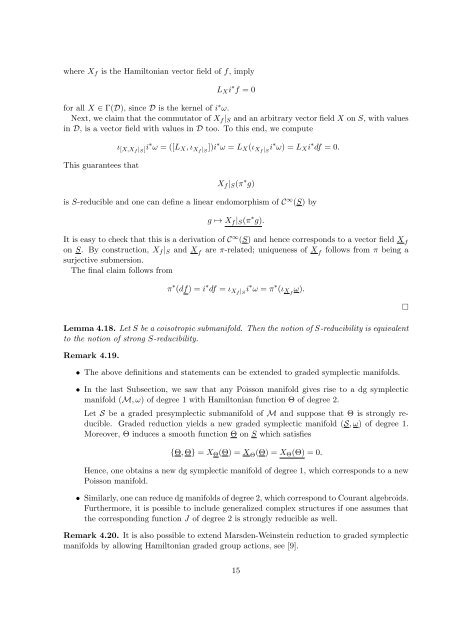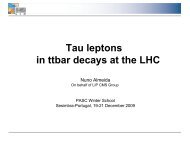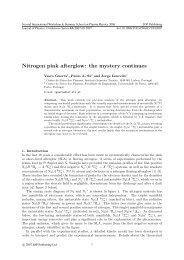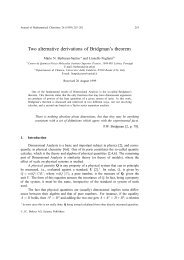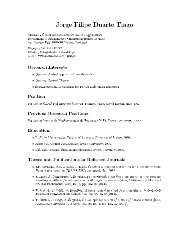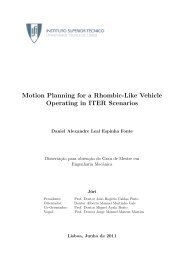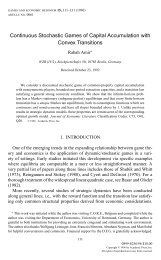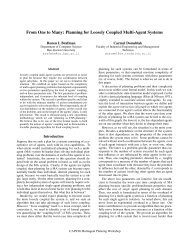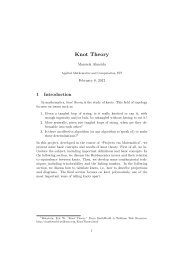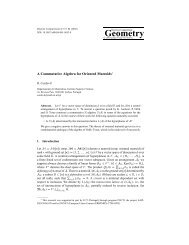Introduction to supergeometry
Introduction to supergeometry
Introduction to supergeometry
Create successful ePaper yourself
Turn your PDF publications into a flip-book with our unique Google optimized e-Paper software.
where X f is the Hamil<strong>to</strong>nian vec<strong>to</strong>r field of f, imply<br />
L X i ∗ f = 0<br />
for all X ∈ Γ(D), since D is the kernel of i ∗ ω.<br />
Next, we claim that the commuta<strong>to</strong>r of X f | S and an arbitrary vec<strong>to</strong>r field X on S, with values<br />
in D, is a vec<strong>to</strong>r field with values in D <strong>to</strong>o. To this end, we compute<br />
This guarantees that<br />
ι [X,Xf | S ]i ∗ ω = ([L X , ι Xf | S<br />
])i ∗ ω = L X (ι Xf | S<br />
i ∗ ω) = L X i ∗ df = 0.<br />
X f | S (π ∗ g)<br />
is S-reducible and one can define a linear endomorphism of C ∞ (S) by<br />
g ↦→ X f | S (π ∗ g).<br />
It is easy <strong>to</strong> check that this is a derivation of C ∞ (S) and hence corresponds <strong>to</strong> a vec<strong>to</strong>r field X f<br />
on S. By construction, X f | S and X f are π-related; uniqueness of X f follows from π being a<br />
surjective submersion.<br />
The final claim follows from<br />
π ∗ (df) = i ∗ df = ι Xf | S<br />
i ∗ ω = π ∗ (ι Xf ω).<br />
Lemma 4.18. Let S be a coisotropic submanifold. Then the notion of S-reducibility is equivalent<br />
<strong>to</strong> the notion of strong S-reducibility.<br />
Remark 4.19.<br />
• The above definitions and statements can be extended <strong>to</strong> graded symplectic manifolds.<br />
• In the last Subsection, we saw that any Poisson manifold gives rise <strong>to</strong> a dg symplectic<br />
manifold (M, ω) of degree 1 with Hamil<strong>to</strong>nian function Θ of degree 2.<br />
Let S be a graded presymplectic submanifold of M and suppose that Θ is strongly reducible.<br />
Graded reduction yields a new graded symplectic manifold (S, ω) of degree 1.<br />
Moreover, Θ induces a smooth function Θ on S which satisfies<br />
{Θ, Θ} = X Θ (Θ) = X Θ (Θ) = X Θ (Θ) = 0.<br />
Hence, one obtains a new dg symplectic manifold of degree 1, which corresponds <strong>to</strong> a new<br />
Poisson manifold.<br />
• Similarly, one can reduce dg manifolds of degree 2, which correspond <strong>to</strong> Courant algebroids.<br />
Furthermore, it is possible <strong>to</strong> include generalized complex structures if one assumes that<br />
the corresponding function J of degree 2 is strongly reducible as well.<br />
Remark 4.20. It is also possible <strong>to</strong> extend Marsden-Weinstein reduction <strong>to</strong> graded symplectic<br />
manifolds by allowing Hamil<strong>to</strong>nian graded group actions, see [9].<br />
□<br />
15


